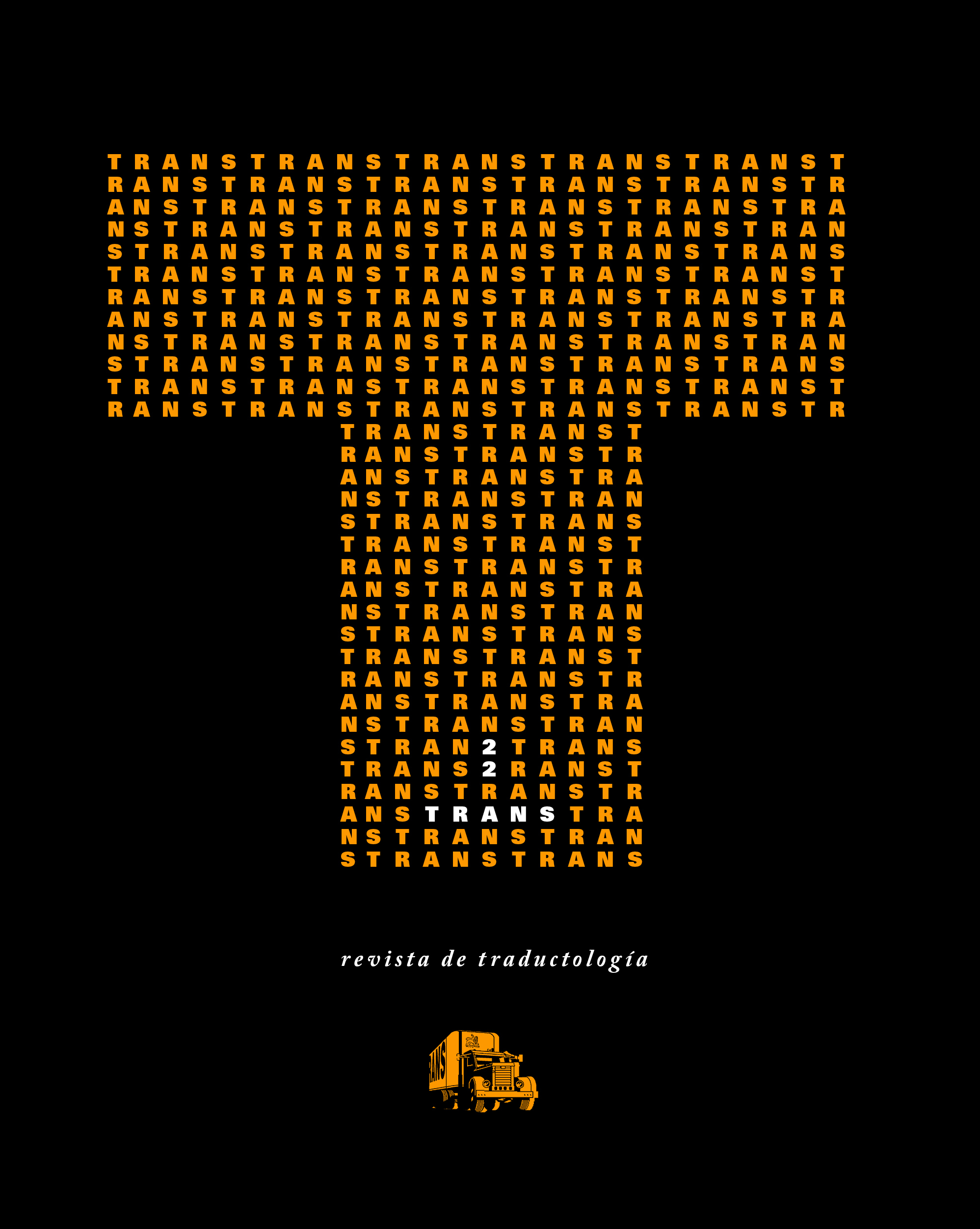The Language of Audio description: Analysis of the Spanish Audio description Script of Ocho Apellidos Vascos (Spanish Affair).
DOI:
https://doi.org/10.24310/TRANS.2018.v0i22.3003Keywords:
Audio description, Dubbese, Audio description Script, Language model, Prefabricated Orality, Accessibility.Abstract
This article is taken from a descriptive study of the language model of audio description (AD) in Spanish. In the absence of similar studies, I have used the prefabricated orality language model in audiovisual fiction texts for Spanish productions (Baños, 2009) as an analytical framework. Its application in the audio description script of the film Ocho apellidos vascos (Spanish Affair) allows us to perform an analysis of the phonetic-prosodic, morphological, lexical and syntactic language levels. After the characterization of these levels for the AD, I have compared the results with both the prefabricated orality of Spanish productions and the dubbese to determine to which of the two the AD language is the closest as a prefabricated orality audiovisual text.
Downloads
Metrics
Publication Facts
Reviewer profiles N/A
Author statements
Indexed in
-
—
- Academic society
- N/A
- Publisher
- Universidad de Málaga
References
AENOR (2005): Norma UNE 153030: Audiodescripción para personas con discapacidad visual. Requisitos para la audiodescripción y elaboración de audioguías, Madrid.
ARCOS URRUTIA, Juan Manuel (2012): «Análisis de guiones audiodescritos y propuestas para la mejora de la norma UNE 153020», Tonos, Revista electrónica de estudios filológicos, 22, <https://www.um.es/tonosdigital/znum22/secciones/estudios-05-la_audiodescripcion.htm> [consulta: 10-IX-2015].
BAÑOS PIÑERO, Rocío (2004): «La oralidad prefabricada en los textos audiovisuales: estudio descriptivo-contrastivo de Friends y Siete Vidas», Fòrum de recerca, 10, <http://hdl.handle.net/10234/79126> [consulta: 19-IX-2015].
BAÑOS PIÑERO, Rocío (2009): La Oralidad prefabricada en la Traducción para el Doblaje: Estudio descriptivo-contrastivo del español de dos comedias de situación: Siete Vidas y Friends. Universidad de Granada, Departamento de Traducción e Interpretación. Tesis doctoral, <http://hera.ugr.es/tesisugr/18319312.pdf> [consulta: 17-IX-2015].
BAÑOS, Rocío (2014): «Orality Markers in Spanish Native and Dubbed Sitcoms: Pretended Spontaneity and Prefabricated Orality», META, 592, 406–435, doi: 10.7202/1027482ar.
BOE (2010): «Ley General Audiovisual», Boletín Oficial del Estado, 79, <https://www.boe.es/buscar/pdf/2010/BOE-A-2010-5292-consolidado.pdf> [consulta: 11-IX-2015].
CESyA, (2014): Seguimiento del subtitulado y la audiodescripción en la TDT, Madrid: Universidad Carlos III, <http://www.cesya.es/sites/default/files/documentos/InformeAccesibilidadTDT2014.pdf> [consulta: 15-IX-2105].
CHAUME, Frederic (2001): «La pretendida oralidad de los textos audiovisuales y sus implicaciones en traducción», en AGOST, R. Y F. CHAUME (eds.), La traducción en los medios audiovisuales, Castellón de la Plana: Publicaciones de la Universitat Jaume I, 77-88.
CHAUME, Frederic (2004): Cine y Traducción, Madrid: Cátedra.
CHAUME, Frederic(2012): Audiovisual Translation: Dubbing, Londres y Nueva York: Routledge.
DÍAZ CINTAS, Jorge (2007): «Traducción audiovisual y accesibilidad» en JIMÉNEZ HURTADO, C. (ed.): Traducción y accesibilidad. Subtitulación para sordos y audiodescripción para ciegos: nuevas modalidades de Traducción Audiovisual. Frankfurt: Peter Lang, 9-23.
JIMÉNEZ HURTADO, Catalina (2007a): «La Audiodescripción desde la representación del conocimiento general. Configuración semántica de una gramática local del texto audiodescrito», Linguistica Antverpiensia, 6:345-346, <https://lans-tts.uantwerpen.be/index.php/LANS-TTS/article/viewFile/196/127> [consulta: 12-X-2015].
JIMÉNEZ HURTADO, Catalina (2007b): «Una gramática local del guion audiodescrito. Desde la semántica a la pragmática de un nuevo tipo de traducción» en JIMÉNEZ HURTADO, C. (ed.): Traducción y accesibilidad. Subtitulación para sordos y audiodescripción para ciegos: nuevas modalidades de Traducción Audiovisual. Frankfurt: Peter Lang, 55-79.
MATAMALA, Anna (2005): «Live Audio Description in Catalonia», Translating Today, 4: 9-11.
ORERO, Pilar (2007): «Audiosubtitling: A Possible Solution for Opera Accessibility in Catalonia», TradTerm, 13: 135-149.
RAMOS CARO, Marina (2013): El impacto emocional de la Audiodescripción. Universidad de Murcia, Facultad de Letras. Tesis doctoral, <https://digitum.um.es/xmlui/handle/10201/36475> [consulta: 13-VIII-2015].
Downloads
Published
How to Cite
Issue
Section
License
All contents published in TRANS. Revista de Traductología are protected under the Creative Commons Attribution-NonCommercial-ShareAlike 4.0 International (CC BY-NC-SA 4.0) license. All about this license is available in the following link: <http://creativecommons.org/licenses/by-nc-sa/4.0>
Users can copy, use, redistribute, share and exhibit publicly as long as:
- The original source and authorship of the material are cited (Journal, Publisher and URL of the work).
- It is not used for comercial purposes.
- The existence of the license and its especifications are mentioned.
- ShareAlike — If you remix, transform, or build upon the material, you must distribute your contributions under the same license as the original.
There are two sets of authors’ rights: moral and property rights. Moral rights are perpetual prerogatives, unrenounceable, not-transferable, unalienable, imprescriptible and inembargable. According to authors’ rights legislation, TRANS. Revista de Traductología recognizes and respects authors moral rights, as well as the ownership of property rights, which will be transferred to University of Malaga in open access.
The property rights are referred to the benefits that are gained by the use or the dissemination of works. TRANS. Revista de Traductología is published in an open access form and it is exclusively licenced by any means for doing or authorising distribution, dissemination, reproduction, , adaptation, translation or arrangement of works.
Authors are responsable for obtaining the necessary permission to use copyrighted images.













21.png)
